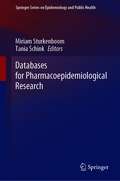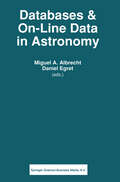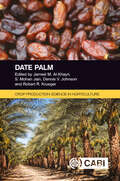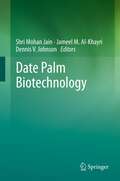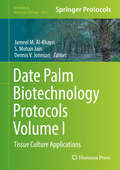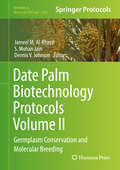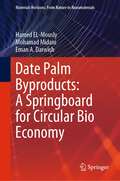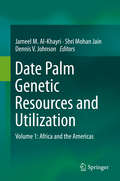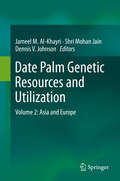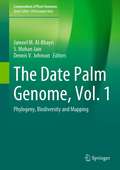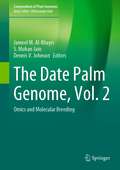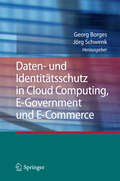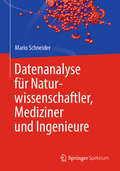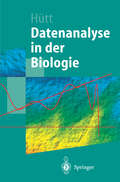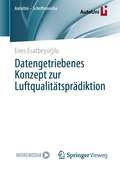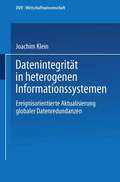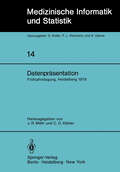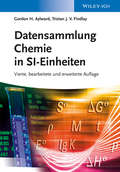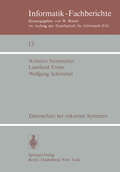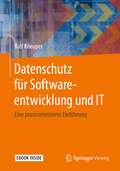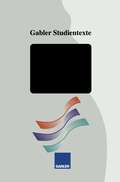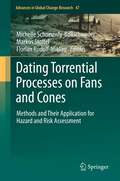- Table View
- List View
Databases for Pharmacoepidemiological Research (Springer Series on Epidemiology and Public Health)
by Miriam Sturkenboom Tania SchinkThis book allows readers to gain an in-depth understanding of the role of real-world data in pharmacoepidemiology, and highlights the strengths and limitations of the respective databases with regard to pharmacoepidemiological research. Over the past decade, the increasing use of real-world data in pharmacoepidemiological research has been accompanied by a growing recognition of the value of real-world evidence in clinical and regulatory decision-making. Electronic healthcare databases allow analyses of drug and vaccine utilization in routine care after approval, as well as investigations of their comparative effectiveness and safety. They are especially useful for the identification of rare risks and rare drug exposures over long periods of time, and as such sustainably extend the basis for drug safety research. This book provides an introduction to the role of real-world data in pharmacoepidemiological research and the main developments in the last 15 years. It also offers a comprehensive overview of the general classification characteristics of databases, together with their strengths and limitations, and a detailed description of 21 individual databases, written by professionals who work with or maintain them.
Databases & On-line Data in Astronomy (Astrophysics and Space Science Library #171)
by M. A Albrecht D. EgretData archiving has, for many years, been the most disregarded aspect of all data systems. The increase in numbers of telescopes, both groundbased and space-borne, and the increase in efficiency of detectors have generated overwhelming amounts of data. Much of these data were and are not used on short timescales and (should) have been archived, where they can be used later and/or by others. Archiving is essential. Objects can change in the course of time. New technological or scientific developments might require observing objects again. The cost-benefit ratio will become more and more important when considering the allocation of telescope time. The retrieval of `old' data can then be crucial. At present there are a number of data collections and data retrieval systems. This book includes a series of clear and up-to-date descriptions of many important available data systems. For professional astronomers, librarians and computer engineers.
Date Palm (Crop Production Science in Horticulture)
by Dr Larbi Abahmane Dr Mohamed Ait-El-Mokhtar Dr Fatima-Zahra Akensous Dr M. Tahir Akram Dr Salah Mohammed Aleid Dr Melkamu Alemayehu Dr Abda Ali Dr Latifa Al-Kharusi Professor Jameel M Al-Khayri Dr Mohammed Al-Mahish Dr Abdulrasoul Mosa Al-Omran Dr Lyutha Al-Subhi Dr Rashid Al-Yahyai Asunción Amorós Dr Mohamed Anli Dr Mohamed Marouf Aribi Dr Raja Ben-Laoaune Dr Houda Besser Dr Neeru Bhatt Dr Abderrahim Boutasknit Dr Roshini Brizmohun Dr Latifa Dhaouadi Dr Gisela Díaz Dr Raga Elzaki Dr Abdessamad Fakhech Dr Mohamed Abusaa Fennir Dr Ibrahim E. Greiby Dr Ayah R. Hilles Professor Shri Mohan Jain Rhonda Janke Dr Muhammad Jafar Jaskani Professor Dennis V Johnson Dr Imran Ul Khan Dr M Mumtaz Khan Dr Rashad Rasool Khan Dr Robert R Krueger Dr Mithlesh Kumar Dr Abdelilah Meddich Dr C. M. Muralidharan Dr Summar Abbas Naqvi Dr Taseer Abbas Naqvi Dr Concepción Obón Dr Redouane Ouhaddou Dr Ozcan Ozturk Dr Ouissame Raho Dr Diego Rivera Dr Ricardo Salomón-Torres Dr Kapil Mohan Sharma Mostafa I. Waly Dr Muhammad Waseem Dr Glenn C. WrightDate palm (Phoenix dactylifera L.) is a tree belonging to the palm family (Arecaceae) and is cultivated for its sweet edible fruits. Over the past century, it has become a major commercial fruit crop and a key component of agricultural production in the world's subtropical arid and semiarid regions. A crop suited both to the low-input small-farmer and the modern high-input commercial plantation, the date palm provides a livelihood for millions of people living in marginal land areas where farming options are restricted. Date palm is mainly grown for its fruits, but the whole tree is utilized. Research into date palm improvement for fruit production in recent decades has brought about improved elite cultivars, stress and pathogen resistance, and enhanced postharvest technologies. These developments have led to revised recommendations for date palm producers, and increased opportunity to promote novel fruit products. This book provides: · A practical manual on modern date palm cultivation methods. · Best practice guidelines for optimal production levels of high-quality fruit. · Opportunities for more complete utilization of date palm products at both the subsistence and commercial levels of production. With contributions from leading international experts, this is a valuable resource for researchers and students in horticulture, as well as date palm growers and processors.
Date Palm Biotechnology
by Shri Mohan Mohan Jain, Jameel M. M. Al-Khayri and Dennis V. V. JohnsonThis important reference book is the first comprehensive resource worldwide that reflects research achievements in date palm biotechnology, documenting research events during the last four decades, current status, and future outlook. This book is essential for researchers, policy makers, and commercial entrepreneurs concerned with date palm. The book is invaluable for date palm biotechnology students and specialists. This monument is written by an international team of experienced researchers from both academia and industry. It consists of five sections covering all aspects of date palm biotechnology including A) Micropropagation, B) Somaclonal Variation, Mutation and Selection, C) Germplasm Biodiversity and Conservation, D) Genetics and Genetic Improvement, and E) Metabolites and Industrial Biotechnology. The book brings together the principles and practices of contemporary date palm biotechnology. Each chapter contains background knowledge related to the topic, followed by a comprehensive literature review of research methodology and results including the authors own experience including illustrative tables and photographs.
Date Palm Biotechnology Protocols Volume I: Tissue Culture Applications (Methods in Molecular Biology #1637)
by Jameel M. Al-Khayri, S. Mohan Jain and Dennis V. JohnsonThis two-volume book is a valuable resource to students, researchers, scientists, commercial producers, consultants and policymakers interested in agriculture or plant sciences particularly in date palm biotechnology. Date Palm Biotechnology Protocols, Volume 1: Tissue Culture and Applications is comprised of 27 chapters covering adventitious organogenesis, somatic embryogenesis, contamination, hyperhydricity, acclimatization, cell suspension, protoplast and bioreactors, genetic transformation secondary metabolites, and abiotic stress. Written in the highly successful Methods in Molecular Biology series format, chapters include introductions to their respective topics, lists of the necessary materials and reagents, step-by-step, readily reproducible laboratory protocols, and tips on troubleshooting and avoiding known pitfalls. Authoritative and practical, Date Palm Biotechnology Protocols, Volume 1: Tissue Culture and Applications aims to supplement the previous volume and to provide precise stepwise protocols in the field of date palm biotechnology.
Date Palm Biotechnology Protocols Volume II: Germplasm Conservation and Molecular Breeding (Methods in Molecular Biology #1638)
by Jameel M. Al-Khayri, S.Mohan Jain and Dennis V. JohnsonThis two-volume book is a valuable resource to students, researchers, scientists, commercial producers, consultants and policymakers interested in agriculture or plant sciences particularly in date palm biotechnology. Chapters in Date Palm Biotechnology Protocols: Volume 2: Germplasm Conservation and Molecular Breeding guides readers through methods and protocols on germplasm in vitro conservation, molecular analysis of in vitro cultures, genetic diversity, cultivar identity, gender identification, genomics, and proteomics. Written in the highly successful Methods in Molecular Biology series format, chapters include introductions to their respective topics, lists of the necessary materials and reagents, step-by-step, readily reproducible laboratory protocols, and tips on troubleshooting and avoiding known pitfalls.Authoritative and practical, Date Palm Biotechnology Protocols: Volume 2: Germplasm Conservation and Molecular Breeding aims to supplement the previous volume and to provide precise stepwise protocols in the field of date palm biotechnology.
Date Palm Byproducts: A Springboard for Circular Bio Economy (Materials Horizons: From Nature to Nanomaterials)
by Hamed EL-Mously Mohamad Midani Eman A. DarwishThis comprehensive book presents an alternative fresh look at date palm byproducts as a springboard for the future circular bio economy. The book shows and exemplifies how these sustainable biomaterials can be the base for a wide spectrum of products and uses. Examples of these numerous products and uses are demonstrated and categorized into five principal uses: i) pharmaceutical, cosmetics and natural wax ,ii) textiles and composites, cellulose and cellulose derivatives, iii)timber and wood substitutes, architecture insulation and building materials, iv) organic fertilizer, compost and soil amendment and water treatment purposes, v) natural fodder and silage , green fuels and bioenergy.
Date Palm Genetic Resources and Utilization: Volume 1: Africa and the Americas
by Jameel M. Al-Khayri Shri Mohan Jain Dennis V. JohnsonThis important 2-volume reference book is the first comprehensive resource reflecting the current global status and prospects of date palm cultivation by country. This volume covers Africa and the Americas. Countries included are: Egypt, Algeria, Sudan, Tunisia, Libya, Morocco, Mauritania, Niger, Cameroon, Djibouti, Chad, Mali Somalia, Ethiopia, Burkina Faso and Senegal, as well as the United States of America and the South American countries Chile and Peru. Topics discussed are: cultivation practices; genetic resources and breeding; conservation and germplasm banks; cultivar classification and identification based on morphological and molecular markers; micropropagation and progress toward scale-up production; and advances in dates processing and marketing. Chapters are supported by tables and color photographs. Appendixes summarize traits and distribution of major cultivars, commercial resources of offshoots and in vitro plants; and institutions and scientific societies concerned with date palm.
Date Palm Genetic Resources and Utilization: Volume 2: Asia and Europe
by Jameel M. Al-Khayri Shri Mohan Jain Dennis V. JohnsonThis important 2-volume reference book is the first comprehensive resource reflecting the current global status and prospects of date palm cultivation by country. This volume covers Asia and Europe. The Asian countries included are: Iran, Saudi Arabia, Iraq, Pakistan, Oman, Yemen, Israel, Kuwait, Qatar, Bahrain, Syria, Palestine and India. Europe is represented by Spain. Topics discussed are: cultivation practices; genetic resources and breeding; conservation and germplasm banks; cultivar classification and identification based on morphological and molecular markers; micropropagation and progress toward scale-up production; and advances in dates processing and marketing. Chapters are supported by tables and color photographs. Appendixes summarize traits and distribution of major cultivars, commercial resources of offshoots and in vitro plants; and institutions and scientific societies concerned with date palm.
The Date Palm Genome, Vol. 1: Phylogeny, Biodiversity and Mapping (Compendium of Plant Genomes)
by Jameel M. Al-Khayri S. Mohan Jain Dennis V. JohnsonThis book is the first volume of a comprehensive assemblage of contemporary knowledge relevant to genomics and other omics in date palm. Volume 1 consists of 11 chapters arranged in 3 parts grouped according to subject. Part I, Biology and Phylogeny, focuses on date palm biology, evolution and origin. Part II, Biodiversity and Molecular Identification, covers conformity of in vitro derived plants, molecular markers, barcoding, pollinizer genetics and gender determination. Part III, Genome Mapping and Bioinformatics, addresses genome mapping of nuclear, chloroplast and mitochondrial DNA, in addition to a chapter on progress made in date palm bioinformatics. This volume represents the efforts of 30 international scientists from 10 countries and contains 78 figures and 30 tables to illustrate presented concepts. Volume 2 is published under the title: Omics and Molecular Breeding.
The Date Palm Genome, Vol. 2: Omics and Molecular Breeding (Compendium of Plant Genomes)
by Jameel M. Al-Khayri S. Mohan Jain Dennis V. JohnsonThis book is the first comprehensive assemblage of contemporary knowledge relevant to genomics and other omics in date palm. Volume 2 consists of 11 chapters. Part I, Nutritional and Pharmaceuticals Properties, covers the utilization of date palm as an ingredient of various food products, a source of bioactive compounds and the production of nanomaterials. Part II, Omics Technologies, addresses omics resources, proteomics and metabolomics. Part III, Molecular Breeding and Genome Modification, focuses on genetic improvement technologies based on mutagenesis, quantitative traits loci and genome editing. Part IV, Genomics of Abiotic and Biotic Stress, covers metagenomics of beneficial microbes to enhance tolerance to abiotic stress and the various genomics advances as they apply to insect control. This volume represents the efforts of 34 international scientists from 12 countries and contains 65 figures and 19 tables to illustrate presented concepts. Volume 1 is published under the title: Phylogeny, Biodiversity and Mapping.
Daten- und Identitätsschutz in Cloud Computing, E-Government und E-Commerce
by Georg Borges and Jörg SchwenkFür neue und künftige Geschäftsfelder von E-Commerce und E-Government stellen der Datenschutz und der Identitätsschutz wichtige Herausforderungen dar. Renommierte Autoren aus Wissenschaft und Praxis widmen sich in dem Band aktuellen Problemen des Daten- und Identitätsschutzes aus rechtlicher und technischer Perspektive. Sie analysieren aktuelle Problemfälle aus der Praxis und bieten Handlungsempfehlungen an. Das Werk richtet sich an Juristen und technisch Verantwortliche in Behörden und Unternehmen sowie an Rechtsanwälte und Wissenschaftler.
Datenanalyse für Naturwissenschaftler, Mediziner und Ingenieure
by Mario SchneiderDieses Buch bietet Ihnen eine verständlich vermittelte Ausgangsbasis für die praktische Anwendung datenanalytischer Methoden, die sinnvolle Interpretation von Daten und die Ableitung von Informationen. Dabei setzt dieses Buch anstelle langer mathematischer Herleitungen und Beweise auf konkrete Beispiele, die jeweils Schritt für Schritt nachvollzogen werden. Die ausgewählten Beispieldaten werden mit Hilfe von Excel analysiert und das Erlernte kann anhand von Übungsaufgaben überprüft werden. Zusätzlich können Sie in Onlinevideos die Rechenschritte nachvollziehen und parallel in Excel mitrechnen. Damit liefert Ihnen dieses Buch nicht nur das für die wissenschaftliche Praxis notwendige Basiswissen der Datenanalyse, sondern bietet gleichermaßen das Fundament für einen souveränen Umgang mit den entsprechenden Instrumenten. Dieses Buch unterstützt somit Naturwissenschaftler, Mediziner und Ingenieure in Studium und Praxis und bietet einen leichten Einstieg in die statistische Datenanalyse und ihre Anwendung in Excel.
Datenanalyse in der Biologie: Eine Einführung in Methoden der nichtlinearen Dynamik, fraktalen Geometrie und Informationstheorie (Springer-Lehrbuch)
by Marc-Thorsten HüttDatenanalyse geht heute weit über die Ermittlung einfacher Mittelwerte, Varianzen und Signifikanztests hinaus. Ein Großteil der experimentellen Untersuchungen erfordert aufwändige mathematische Methoden. Der Autor stellt besonders bemerkenswerte und elegante Analysestrategien aus der Forschungsliteratur der letzten zehn Jahre vor. Drei wesentlichen Techniken der fortgeschrittenen Datenanalyse sind Einzelkapitel gewidmet: nichtlineare Zeitreihenanalyse, Methoden der fraktalen Geometrie und Analyse von Daten mit raumzeitlicher Dynamik.
Datengetriebenes Konzept zur Luftqualitätsprädiktion (AutoUni – Schriftenreihe #154)
by Enes EsatbeyoǧluEnes Esatbeyoǧlu verfolgt den Ansatz, die NO2-Konzentrationen als Indikator für die Luftqualität mit einem Fahrzeug und zwei verschiedenen Sensoren (Referenz und miniaturisiert) zu messen und darauf basierend ein datengetriebenes Prädiktions- und Adaptionskonzept zu entwickeln. Die Datenerhebung erfolgt dabei auf einer vordefinierten Route zu verschiedenen Zeiten sowie Umwelt- und Verkehrsbedingungen. Für die Prädiktion der Luftqualität und Adaption der Sensordaten wendet er verschiedene Machine Learning Modelle an. Dabei untersucht er die Performantesten auf Robustheit, Generalisierbarkeit und Übertragbarkeit.Der AutorEnes Esatbeyoglu studierte Maschinenbau und Kraftfahrzeugtechnik. Anschließend hat er berufsbegleitend mit der vorliegenden Schrift an der OVGU Magdeburg promoviert und ist jetzt im Bereich der Konzeptvorentwicklung eines Automobilkonzerns tätig.
Datenintegrität in heterogenen Informationssystemen: Ereignisorientierte Aktualisierung globaler Datenredundanzen (DUV Wirtschaftswissenschaft)
by Joachim KleinViele Unternehmen haben in der Vergangenheit unterschiedliche Hardware- und Softwaresysteme installiert und dadurch "Insellösungen" geschaffen. Eine ganzheitliche Abwicklung unternehmensspezifischer Aufgaben setzt aber voraus, daß Datenredundanzen, die geplant oder ungeplant bei der Installation entstanden sind, stets die gleiche Aktualität aufzeigen. Um diese Voraussetzung erfüllen zu können, muß ein modernes Informationsmanagement neben dem Wissen über die inhaltlichen Zusammenhänge der Daten auch über ein geeignetes Instrumentarium zur Gewährleistung der Aktualität globaler Datenredundanzen verfügen. Den Unternehmen stellt sich die Frage, durch weIche Maßnahmen eine kostengünstige Migration zum integrierten Informationssystem erreicht werden kann. Eine weit verbreitete Vorgehensweise besteht in der direkten Kopplung der DV-Systeme über sogenannte "Schnittstellen", Die Organisation und die Administration dieser Schnittstellen ist besonders problematisch, da für jede Kopplung festgelegt werden muß, zu welchem Zeitpunkt und in weIchem Format Informationen auszutauschen sind und die Anzahl der Schnittstellen quadratisch mit der Zahl der zu koppelnden DV-Systeme steigt. In dem vorliegenden Buch greift der Autor diese Problematik auf und stellt die Konzeption eines konfigurierbaren Informationsmanagementsystems vor. Die Grundlage der Konzeption bildet die These, daß der Austausch von Daten nicht direkt über Schnittstellen zwischen zwei DV -Systemen, sondern indirekt über ein Informationsmanagementsystem ertolgen sollte. Dies hat den Vorteil, daß die zu übertragenden Daten im ersten Schritt in ein neutrales Format überführt werden können. Im zweiten Schritt ist dann eine individuelle Anpassung und Verteilung der Daten an unterschiedliche DV-Systeme möglich. Diese Vorgehensweise reduziert die Anzahl der Schnittstellen und steigert die Flexibilität bei der Integration weiterer DV -Systeme.
Datenpräsentation: 6. Frühjahrstagung der Deutschen Gesellschaft für Medizinische Dokumentation, Informatik und Statistik Heidelberg, 1.–3. März 1979 (Medizinische Informatik, Biometrie und Epidemiologie #14)
by J. R. Möhr C. O. KöhlerDatensammlung Chemie in SI-Einheiten
by Gordon H. Aylward Tristan J. FindlayMan möchte vor dem Experiment die Wärmeentwicklung einer Reaktion abschätzen, eine neue Syntheseidee auf Plausibilität prüfen oder die Kenngrößen einer neuen Substanz in Beziehung zu bereits bekannten setzen – dies bedeutet meist für jeden Wissenschaftler einen zeitaufwendigen Besuch in der Bibliothek. In diesem Buch sind die Daten für alle wichtigen anorganischen und organischen Substanzen zuverlässig und schnell zu finden. Diese kompakte Datensammlung enthält genau die Werte, die jeder Chemiker immer wieder benötigt. Alle Daten stehen untereinander in Beziehung und sind aufeinander abgestimmt. Für alle Größen werden die SI-Einheiten verwendet, doch sind natürlich die entsprechenden Umrechnungsfaktoren für Nicht-SI-Einheiten angegeben. Die Neuauflage wurde vollständig aktualisiert, um 20% erweitert und enthält die jeweiligen Sicherheitshinweise. Das Buch deckt mit einzigartigem Detailreichtum ein großes Spektrum an Daten zu anorganischen und organischen Substanzen ab. Dieses Werk ist der ideale Begleiter für Chemiestudenten sowie Anorganiker und Organiker im Beruf.
Datensammlung Chemie in SI-Einheiten
by Gordon H. Aylward Tristan J. FindlayMan möchte vor dem Experiment die Wärmeentwicklung einer Reaktion abschätzen, eine neue Syntheseidee auf Plausibilität prüfen oder die Kenngrößen einer neuen Substanz in Beziehung zu bereits bekannten setzen – dies bedeutet meist für jeden Wissenschaftler einen zeitaufwendigen Besuch in der Bibliothek. In diesem Buch sind die Daten für alle wichtigen anorganischen und organischen Substanzen zuverlässig und schnell zu finden. Diese kompakte Datensammlung enthält genau die Werte, die jeder Chemiker immer wieder benötigt. Alle Daten stehen untereinander in Beziehung und sind aufeinander abgestimmt. Für alle Größen werden die SI-Einheiten verwendet, doch sind natürlich die entsprechenden Umrechnungsfaktoren für Nicht-SI-Einheiten angegeben. Die Neuauflage wurde vollständig aktualisiert, um 20% erweitert und enthält die jeweiligen Sicherheitshinweise. Das Buch deckt mit einzigartigem Detailreichtum ein großes Spektrum an Daten zu anorganischen und organischen Substanzen ab. Dieses Werk ist der ideale Begleiter für Chemiestudenten sowie Anorganiker und Organiker im Beruf.
Datenschutz bei riskanten Systemen: Eine Konzeption entwickelt am Beispiel eines medizinischen Informationssystems (Informatik-Fachberichte #13)
by W. Steinmüller L. Ermer W. SchimmelDatenschutz für Softwareentwicklung und IT: Eine praxisorientierte Einführung
by Ralf KneuperDieses Buch beschreibt das Thema Datenschutz aus der Sicht von Softwareentwicklung und IT. Die Verantwortlichen in diesen Bereichen gestalten die praktische Umsetzung des Datenschutzes zu erheblichen Teilen mit, benötigen dafür aber entsprechende Kenntnisse über die rechtlichen Rahmenbedingungen und Möglichkeiten zu deren Umsetzung. Der Fokus dieses Buchs liegt daher auf den Aspekten des Datenschutzes, die durch Softwareentwicklung stark beeinflusst werden, wie z.B. Privacy by Design, Privacy by Default, Datenminimierung, Umsetzung von Auskunftsrechten sowie Datenlöschung.
Datenschutzrecht - Schnell erfasst (Recht - schnell erfasst)
by Flemming MoosDas Buch ermöglicht eine schnelle aber gleichwohl fundierte Einarbeitung in das Datenschutzrecht. Es ist insbesondere an Rechtsanwälte, Datenschutzbeauftragte und andere Praktiker sowie Studierende gerichtet, die sich erstmals vertieft mit dem Datenschutzrecht beschäftigen. In einer kurzen Einführung werden die Ziele, die Historie und die Rechtsquellen des Datenschutzrechts sowie der Anwendungsbereich der datenschutzrechtlichen Vorschriften erläutert. Im Anschluss daran erfolgt eine Darstellung der zentralen datenschutzrechtlichen Grundsätze, wie etwa des Zweckbindungsgrundsatzes etc. Weitere Kapitel beschäftigen sich ausführlich mit den Anforderungen an die Zulässigkeit der Datenverarbeitung und den ergänzenden Verpflichtungen, z.B. auf Unterrichtung, Auskunft etc. Abschließend geht der Autor auf datenschutzrechtliche Besonderheiten in spezifischen Wirtschaftsbereichen ein und erläutert diese eingehend.
Dating Torrential Processes on Fans and Cones: Methods and Their Application for Hazard and Risk Assessment (Advances in Global Change Research #47)
by Michelle Schneuwly-Bollschweiler, Markus Stoffel and Florian Rudolf-MiklauThis book provides a detailed overview on methods used for the dating of past torrential activity on fans and cones and fosters the discussion on the impact of past and potential future climate change on torrential processes. The book has a clear focus on the practical applications of these methods, complemented by case studies. The limits of each dating method in case of excessive natural and human interventions on fans and cones are shown.
